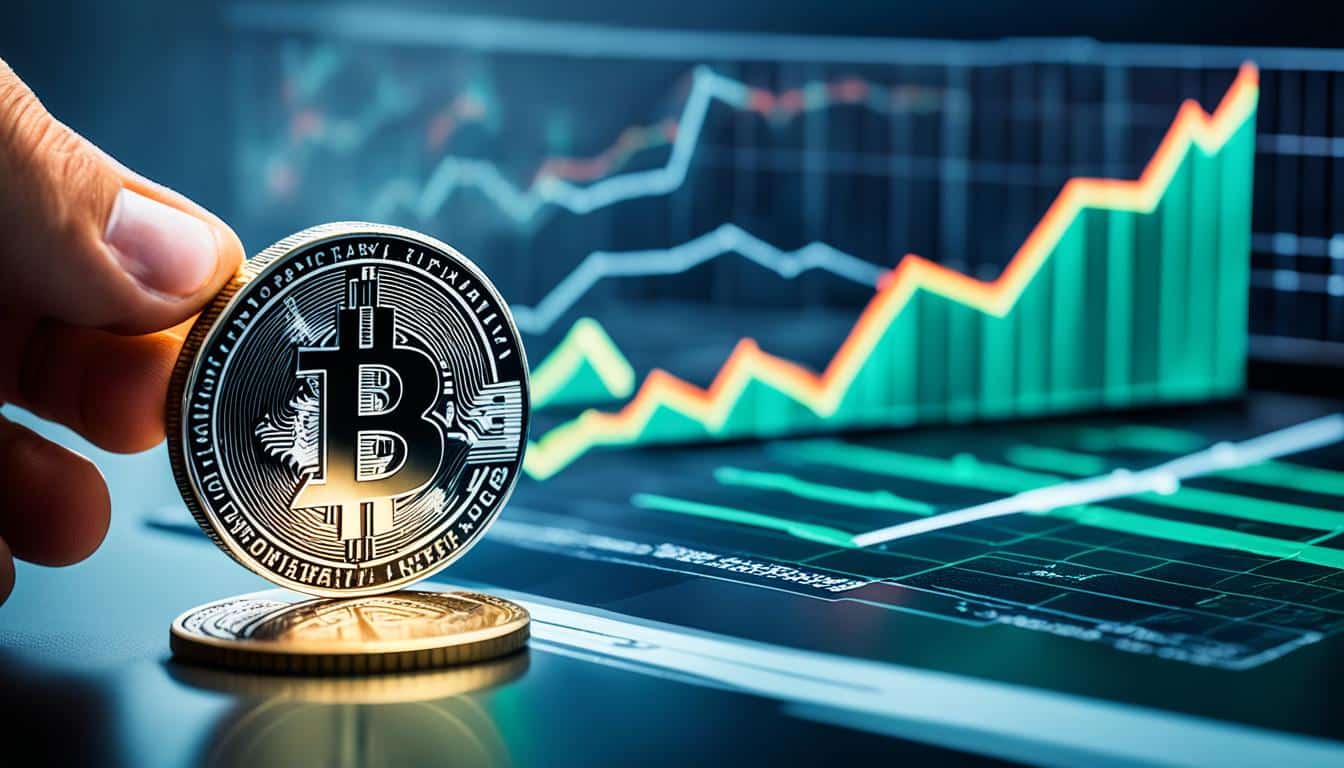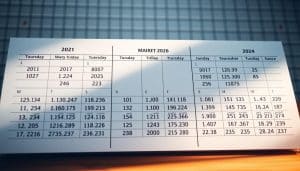Did you know Bitcoin once dropped by 77% from its peak? This shows how unpredictable the crypto market is. That’s why it’s key to have a strong risk management strategy if you trade crypto-assets1. As more people see trading crypto as an option instead of traditional stocks, it’s crucial to know how to manage risks2.
Trading in cryptocurrency can offer big rewards but comes with high risks. It’s important to understand how critical a dependable risk management strategy is. This guide will help you learn how to handle risks in the crypto world. That way, you can trade wisely and safely.
Key Takeaways
- The crypto market’s volatility shows the need for strong risk management1.
- It’s essential to have a risk management strategy for your crypto-assets to protect your capital and stay profitable12.
- High leverage might lead to big losses, highlighting the importance of careful trading1.
- Trusted platforms and secure storage play a big part in managing your crypto trading risks1.
- Keeping your emotions in check and knowing the market well are key for managing risks effectively12.
Understanding Crypto Trading
When you jump into crypto trading, it’s important to grasp the basics first. You need to know how it differs from traditional trading. By understanding cryptocurrencies and how their market works, you can handle the ups and downs better. This part talks about cryptocurrency basics, its differences from old-school trading, and why the market can be so unpredictable.
What is Cryptocurrency?
Cryptocurrency is digital money that uses blockchain to stay safe and transparent. It’s not controlled by any government or bank. Big names like Bitcoin and Ethereum use this blockchain tech. This tech makes every transaction open and very hard to change.
Blockchain is key for keeping cryptocurrency safe. It makes sure transactions are checked and logged without middlemen. This is very different from traditional banks. That’s why lots of folks find cryptocurrency a good option besides regular banking.
How Does Crypto Trading Differ from Traditional Trading?
Crypto trading and traditional trading don’t work the same way. Traditional trades happen on big stock exchanges with company shares. But, crypto trading happens on crypto exchanges like KuCoin. Here, people buy and sell digital money like Bitcoin and Ethereum.
Another big difference is when you can trade. Stock markets open and close, but crypto markets never sleep—they’re open 24/7. This means you always have to be on your toes. Also, crypto trading lets you borrow a lot more money for trades. But, if prices move just 1% against you, you could lose a lot3.
The Volatility of the Crypto Market
The crypto market can change a lot and very quickly. This can mean big wins or big losses. Like in May 2022, when a coin called terraUSD fell sharply3.
We use tools like standard deviation and beta to understand market changes. Standard deviation shows how much prices go up and down. Beta tells us if a cryptocurrency moves more or less than the market4. Knowing these can help you handle the risk.
To deal with market ups and downs, traders often use strategies like Dollar Cost Averaging (DCA). This means buying or selling a little bit at a time. This and knowing about risk can help you stay in the game longer3.
Top Risks in Crypto Trading
Crypto trading brings the chance for high rewards but also many risks. Knowing the key dangers can help a lot in crypto trading risk management. It can also make your plans for risk management in blockchain trading better.
Market Sentiment and Volatility Risks
The value of cryptocurrencies can change quickly because of market feelings. For instance, Bitcoin reached nearly $20,000 in December 2017 but fell to about $3,000 a year after5. This shows how crucial crypto trading risk management is.
Lack of Regulation
The crypto market can work with little rules. This situation can lead to problems like market cheating and scams. When China stopped cryptocurrency trading in 2021, it really shook the market5.
Security Risks
Safety is a big worry. The big Mt. Gox hack in 2014 made 850,000 Bitcoins disappear, showing the dangers5. Good risk management in blockchain trading needs strong safety steps to keep your money safe.
Market Manipulation
Some cryptocurrencies don’t have a lot of activity, making it easier to sway prices. This happened when traders artificially pushed prices of certain altcoins, harming new investors.
Emotional Trading
Trading based on fear or greed can cause bad choices. With the crypto market being so up and down, staying calm is key for good crypto trading risk management.
Lack of Understanding
Not knowing much about blockchain or different cryptos can increase trading hazards. Learning more is crucial to lessen risks and better your risk management in blockchain trading.
The Importance of Risk Management in Crypto Trading
Effective risk management is key to lasting success in crypto trading. It helps protect your money, keep you calm, and make sure your trading lasts. By handling risks wisely, you stay in control.
Preserving Capital
Keeping your capital safe is very important in crypto trading. This is because the market is full of risks. Prices can change fast based on news, global events, and what investors feel. These changes can cause big losses6.
To face this, having a trading plan is a smart move. Also, knowing how much to invest and when to enter or exit can help. Using stop-loss and take-profit orders can also keep you safe from market ups and downs7.
Emotional Control
Keeping your emotions in check is crucial for managing risk. Trading too much because of feelings, not logic, can hurt your investment7. It’s better to trade with a clear plan and stay cool.
A disciplined way of trading stops you from making quick, poor decisions. Writing down your trading moves and feelings can also help. It shows you what works and what doesn’t, making your strategy better7.
Sustainability
For trading to last, thinking long-term is important. Applying risk management well helps you keep going, even when the market is tough. A planned approach to risk can lead to success in the unpredictable crypto world.
| Risk Factor | Impact | Mitigation |
|---|---|---|
| Market Risk | Substantial losses due to unpredictable price movements influenced by market news, global events, and investor sentiment | Implement a trading plan, use position sizing, and employ stop-loss and take-profit orders67 |
| Liquidity Risk | Difficulty in buying or selling at fair prices due to inadequate liquidity in smaller or less-known cryptocurrencies | Trade in more liquid cryptocurrencies and evaluate liquidity before entering trades6 |
| Operational Risk | Losses due to internal system failures, trading errors, or hacking and cyber-attacks | Enhance system security, use reputable trading platforms, and verify all trading activities6 |
| Regulatory Risk | Losses due to government regulations, legal actions, or bans on cryptocurrencies | Stay informed about regulatory changes and develop compliance strategies6 |
| Counterparty Risk | The risk of a trading partner defaulting on obligations in peer-to-peer transactions | Use trusted platforms and verify counterparties’ credibility6 |
Risk Management Strategies
Effective risk management strategies are key for doing well in cryptocurrency trading. By using a strict approach, you can better deal with the ups and downs of the market and protect your money.
Plan Your Trades
Planning your trades is crucial in controlling risk in cryptocurrency trades. You should set clear start and finish points based on solid research8. Technical analysis can help cut down on guesses. It lets you make choices based on past price moves8. This not only helps with risk but also lifts your chances for successful trades.
Don’t Panic Sell
Panic selling often happens when the market drops. But, it’s important to stay cool and stick to your plan. Being in control of your feelings is key in crypto asset risk assessment. Having good emotional control keeps you from making hasty choices that lead to losses8. Emotions like fear and greed are big challenges in trading. Staying disciplined strengthens your ability to manage risks8.
Always Set a Stop Loss
Using a stop loss order is crucial for limiting risk in crypto trades. These orders automatically close your trade at a set price, limiting possible losses and protecting your cash. For instance, a common suggestion is to only risk a small part of your total money on a single trade, about 1-3%8. This plan makes sure your possible losses are controlled and your overall money stays safe.
Don’t Forget to Take Profit
While it’s important to have stop losses, it’s just as critical to take profits at the right moment. Setting up take-profit orders helps to keep your earnings when things go your way. Trailing stop orders add more control by changing your stop price as the market shifts. This way, you can keep your earnings and gain more if the market goes up8. Smartly taking your profits is a main part of good crypto asset risk management. It helps you grow and keep your trading money over time.
| Risk Management Strategy | Benefit |
|---|---|
| Plan Your Trades | Reduces guesswork, increases success rate |
| Don’t Panic Sell | Prevents unnecessary losses, maintains discipline |
| Set Stop Loss | Minimizes potential losses, preserves capital |
| Take Profit | Locks in gains, secures profits |
Choosing a Reliable Crypto Trading Platform
When choosing a cryptocurrency exchange, it’s key to pick one that’s safe and follows rules. KuCoin is a good choice because it offers strong security and has reliably served users worldwide.
Cryptos can change in price quickly, making a secure platform essential for steady trading9. Your platform should also have strong security all the time, even when you’re not trading9.
It helps if your platform offers proven trading strategies. For instance, some give you 100 free strategies to follow the market better10. Having access to technical analysis and advanced tools is crucial for making good decisions910.
Look for platforms that allow you to invest in many cryptos. This spreads the risk and lessens the blow of market swings911.
Make sure your crypto exchange matches your approach to managing risk. It should have the right tools, support safe trading, and help you diversify. Picking wisely can improve your trading and help manage risks better.
Pick a Secure Storage Option to Hold Your Crypto Assets
Keeping your crypto safe is key in managing your portfolio. In 2022, thieves stole $3.8 billion in cryptocurrency, but by 2023, this dropped to $1.7 billion12. Using the right storage can really help protect your crypto investments.
For top-notch security, think about getting a hardware wallet like Ledger or Trezor. These wallets aren’t online, making it harder for hackers to get in. They’ve become essential, especially since DeFi protocols were often hacked in 2021, 2022, and 202312.
If you need to access your crypto quickly, consider a hot wallet. Just make sure to turn on two-factor authentication (2FA) for extra safety. This step is crucial for avoiding hacks, like the one that cost Crypto.com $35 million13. It’s also good protection against phishing, a big risk in the crypto scene14.
Think about using multi-signature (multi-sig) wallets too. They need more than one person to say yes before any crypto moves. This can stop thieves if they find a weak spot. They’re really useful because around 17% of Bitcoin is lost forever, just because people forgot their keys12.
Also, keep your seed phrases in a safe place. These words are like the master key to your wallet. Losing them means trouble for getting back lost or stolen cryptos.
Below is a comparison of secure storage options to illustrate their distinct security features:
| Storage Option | Security Features | Recommended Use |
|---|---|---|
| Hardware Wallets (Ledger, Trezor) | Offline storage, strong encryption, reduced hacking risk | Long-term holdings |
| Hot Wallets | 2FA, quick access, convenient for trading | Frequent use and trading |
| Multi-signature Wallets | Approval from multiple users, enhanced security, reduced single point of failure | High-value transactions, business use |
Picking the right storage and upping your security can really shield your crypto. This way, you’re better off guarding against the risks in your portfolio.
Do Your Own Research (DYOR)
Before jumping into trading crypto, it’s crucial to do your own research (DYOR). You need to look closely at projects before investing. Doing this helps make smart choices.
Fundamental Analysis
Looking at the real worth of a cryptocurrency is what fundamental analysis is all about. It checks out the tech behind the coin, its uses in the market, and who’s running the show. To start, investors should check the team’s past work, the plan for the project, and how involved the community is15.
It’s also smart to look at things like what the coin does, how its money works, and how much the developers are doing. This can show you if a coin is just a trend or a solid choice16. Knowing stuff like Bitcoin being scarce, versus Ethereum’s endless supply, helps avoid bad investments16. This analysis keeps you from tricks like fake hype and scamming15.
Technical Analysis
Technical analysis means looking at past prices and trading volumes. It’s used to guess where the market will go next. With crypto being so unpredictable, this analysis is vital17.
By understanding chart patterns and tools like moving averages, traders can make smarter moves. For example, when Bitcoin fell 30% on May 19, 2021, those who knew their stuff could handle it better17.
Sentiment Analysis
Sentiment analysis is about understanding what people think and feel about a coin. Market feelings can hugely impact investment choices. They are often swayed by fear of missing out or doubts15.
Watching social media, news, and forums lets traders get the mood around a crypto. This helps close in on how feelings might change prices. Knowing this leads to smarter investing.
Putting together fundamental, technical, and sentiment analysis gives a full view for DYOR. It means your investment decisions are well-rounded and informed.
Diversify Your Crypto Portfolio
To cut down on risk and improve your chances for steady gains, spreading your investments across different types of cryptocurrencies and assets is key. Having a mix helps protect your money if one type of cryptocurrency crashes. This strategy acts like a safety net in unpredictable markets.
Looking at two different portfolios from August 2021 over a year highlights the benefits of diversification. One had a mix of Bitcoin, S&P 500, Treasury Bonds, a Commodities Index, and Real Estate. The other only had Bitcoin18. The mixed portfolio showed less extreme ups and downs and generally smoother returns.
For diversification, you can choose from payment tokens, security tokens like those tied to real estate, and utility tokens, for instance, Filecoin. There are also governance tokens such as Uniswap, digital ad tokens like Brave’s, gaming tokens including Decentraland’s MANA, and unique tokens known as NFTs18. Investing in different sectors like healthcare or entertainment further spreads your risk.
Blockchain tech allows for investing in areas like climate action, real estate, and private equity18. You can also diversify by choosing between large or small cryptocurrencies and stablecoins19.
Aside from cryptocurrencies, you might consider investing in crypto company stocks, blockchain bonds, and real estate tokens18. Adding tokenized assets brings in ownership stakes in digital or physical items, like artwork, enhancing your investment spread19.
Widening your portfolio can also mean putting money into initial coin offerings (ICOs) and advanced trading options such as crypto derivatives19. These derivatives, like futures and options, offer experienced investors ways to grow their crypto holdings19.
Moreover, investing through crypto funds, including ETFs, hedge funds, or investment trusts, spreads your bets across the crypto world19. This method is crucial for a strong portfolio that can quickly bounce back from market downturns19.
Diversifying is all about preventing big losses and making your investment journey smoother. It’s a balanced tactic for steering your crypto strategy18.
Set a Trade-Specific Risk/Reward Ratio
It’s key to set a trade-specific risk/reward ratio tailored to your financial goals and comfort with risk. This approach brings more discipline and success to trading.
Understanding Risk/Reward Ratios
The risk/reward (RR) ratio helps traders weigh potential losses against potential wins20. It acts as a guide in deciding how much risk is acceptable for the hope of reward. For example, a stop-loss order can cut losses by selling off cryptocurrency at a set price level20.
The difference between your stop-loss and take-profit levels sets your RR ratio. This is vital for assessing trade risks wisely20. To find it, divide your potential gain by your possible loss. This shows the expected profit for every dollar risked20.
Examples of Risk/Reward Ratios
Setting a risk/reward ratio is crucial for figuring out if the return is worth the risk. A 1:3 ratio, for instance, means risking $1 to possibly make $3. This ensures that wins cover losses21. A basic 1:2 ratio suggests risking $1 for a potential $2 win11. Ideally, aim for a 1:3 ratio or better, which is seen as more favorable21. You can adjust your stop-loss orders to reach this desired balance21.
Before jumping into the market, always do a detailed risk/reward analysis. Such careful planning can boost your trading performance. It helps in recognizing both your possible gains and losses. You can dive deeper into these concepts by checking out risk management in cryptocurrency trading20.
Risk Management Strategy When Trading in Crypto-assets
To win in the crypto world’s ups and downs, having a good risk plan is key. It’s all about keeping your money safe, staying cool under pressure, and knowing how big your bets should be. This way, you protect your investments and set yourself up for success in the future.
Preserving Your Capital
Keeping your money safe is basic but very important. A tip for traders is to not lose more than 1% of their portfolio on a single trade. This careful rule helps avoid big losses and keeps your trading account healthy22.
To reduce losses, limit your trade sizes and set up automatic stop-loss orders22. Using strategies like avoiding, reducing, or sharing risks is key. Tools like impact matrices or heat maps can help make good decisions and keep your portfolio stable23.
Emotional Management
Keeping cool while trading is a must for smart choices. The best traders stick to their plan, without doubting their strategy22. This emotional control stops sudden, risky moves that can lead to losses.
Position Sizing
The right trade size is crucial for managing risks and keeping your money safe. Traders use different methods to make sure no single trade can harm their whole portfolio. Using options like protective puts can also help limit risks22.
By following these sizing rules, you keep your risks small and manageable. This method helps with creating a better trading plan and keeping losses in check.
It’s not just about making money, but keeping it and growing it safely. For more advice on winning with crypto trading, check out this complete guide.
Accept Your Losses
Accepting your losses is key to being a tough and successful trader. It’s important to have a strong mindset and a solid plan. Knowing that losses are part of trading helps you get better and perform well.
One way to handle trading losses is the 1% rule. It means not risking more than 1% of your money on a single trade24. This rule is a lifesaver for day traders with accounts under $100,000. It helps keep losses small and protects your money, especially in the unpredictable crypto market.
Another important tool is using stop-loss orders. They let you leave losing trades at set points so you don’t lose too much25. Setting stop-loss and take-profit points means you have a clear plan based on key averages like the 5-, 9-, 20-, 50-, 100-, and 200-day ones24.
Being OK with both wins and losses creates the right mindset for success. Traders who stay calm and follow their rules can handle the market’s surprises well25. Also, assessing risks like market swings, liquidity, rules, and tech issues is key to managing losses25.
To help reduce trading losses, you should look into hedging strategies. Using options, futures, and derivatives helps balance out potential losses in the crypto world25. Get ready for losses by preparing and always improving your trading plan.
Implement a Trading Journal
Having a trading journal is key for anyone serious about trading. It helps track how you’re doing and improve your choices by looking at your past trades.
Recording Basics
Your trading journal needs to have all important details of your trades. You should note things like what you traded, if you bought or sold, where you traded, and when. Also, include details like how much you bought or sold for, your stop-loss, the outcome of the trade, and why you made the trade26.
By keeping track of these, you can see patterns in how you trade and how you’re performing over time.
Noting Emotions and Thoughts
It’s just as crucial to write down how you felt and what you thought during each trade. This helps you spot what emotions make you trade in certain ways. Understanding these emotional triggers can help you make less impulsive choices and trade more carefully26.
Trade decision analytics help traders see how their feelings affect their decisions.
Review and Learn
Looking over your trading journal often is essential for getting better. This helps you find important patterns and insights in your trades27. For example, by comparing your winning and losing trades, you can see how well you’re doing.
Analyzing how long you hold onto trades shows if your long-term strategies work well27. By continually going over your past trades and learning from them, you can improve your strategies. This leads to managing risks better and making more money.
Also, having your trading journal online keeps your information safe and easy to look at any time27. Overall, the real value of a trading journal comes from regular updates, reflecting on your trades, and continuous learning.
Don’t Over-Trade
Effective crypto trading needs a balance between being active and knowing when to stop. Over-trading can reduce your profits and increase risks. Setting trade limits helps you control your trading better.
Setting Limits
It’s key to set daily or weekly trade limits. This keeps you disciplined in the unpredictable crypto market. High trading volume and market changes can make you want to trade a lot. But this usually doesn’t end well.
Sticking to your trading strategy with limits can prevent losses. This is because you won’t make unnecessary trades.
Following Your Plan
Sticking to your strategy is vital for lasting success. The crypto market’s total worth has moved between $3 trillion and $1.68 trillion lately28. This shows why it’s important to follow your planned approach through ups and downs.
Don’t change your plan due to short-term market changes. Always apply your trading plans to reach your financial goals.
Taking Breaks
Taking breaks can really improve your trading. Regular breaks reduce stress and prevent burnout. These problems are common in day trading and scalping.
With breaks, you can come back to trading with a clear mind, which helps in making better decisions.
Smart trading means going slow and seeing wins and losses as part of the journey. Reducing your crypto exposure to less than 5% of your portfolio helps limit risks. Starting with 1% to 2% of your portfolio is a good way to start safe29.
By setting trade limits, keeping to your strategy, and taking breaks, traders can trade crypto well without over-trading.
Conclusion
To excel in crypto trading, you need to understand the risks and have solid plans to handle them. The crypto market is volatile, with Bitcoin’s returns at about 110% yearly. Yet, it also has an 81% volatility rate30. You must be careful and create a unique plan to manage these risks. This guide aims to strengthen your skills, helping you to deal effectively with the challenges.
Keeping your trading safe means choosing reliable platforms and safe storage. Also, doing your homework through various analyses is key. By spreading your investments and knowing risk/reward balances, your assets stay safer while growing. The rise in crypto hedge funds, from $1 billion to $2 billion in 2019, shows the big potential in this field30.
Adopting habits like writing a trading journal and setting firm trade limits will boost your plan. This stops too much trading and decisions based on emotions. Getting in line with FATF guidelines and EU’s MiCA rules also improves your strategy. This is vital because almost half of the people in a survey faced risks with their counterparts in crypto trades31.
Winning in crypto trading comes with hurdles. Yet, with a well-rounded approach to managing risks, your chances of success grow. Enter the thrilling crypto market with well-thought-out strategies and a focus on safeguarding your investments. Stay informed and be strategic to ensure your assets are always well-protected and managed effectively.
FAQ
What is Cryptocurrency?
How Does Crypto Trading Differ from Traditional Trading?
What Are the Major Risks in Crypto Trading?
Why Is Risk Management Important in Crypto Trading?
How Can I Plan My Trades To Manage Risk?
What Should I Look for In a Reliable Crypto Trading Platform?
How Do I Safely Store My Crypto Assets?
Why Is It Important To Do Your Own Research (DYOR)?
How Can Diversifying My Crypto Portfolio Help in Risk Management?
What Is a Trade-Specific Risk/Reward Ratio?
FAQ
What is Cryptocurrency?
Cryptocurrency is a type of currency that’s digital or virtual. It uses blockchain technology to keep transactions safe and secure. Bitcoin and Ethereum are some examples.
How Does Crypto Trading Differ from Traditional Trading?
Crypto trading is different from traditional trading. It happens on cryptocurrency exchanges like KuCoin. This trading is known for its high volatility and quick price changes.
What Are the Major Risks in Crypto Trading?
Crypto trading comes with risks like market swings and volatility. There’s also less regulation and security risks. To deal with these, you need a strong risk management strategy.
Why Is Risk Management Important in Crypto Trading?
Managing risks in crypto trading helps keep your money safe. It keeps you calm and makes your trading last longer. Being disciplined helps reduce losses and protect your investments.
How Can I Plan My Trades To Manage Risk?
To manage risk, make realistic goals. Know when to start and stop a trade. Using stop loss and take profit orders avoids sudden decisions. This plan is key for a good risk assessment.
What Should I Look for In a Reliable Crypto Trading Platform?
Look for a platform that has strong security, follows rules, and has a great user reputation. Platforms like KuCoin have great security and a big worldwide user base.
How Do I Safely Store My Crypto Assets?
For safe storage, use hardware wallets like Ledger or Trezor for keeping assets long-term. For easy access, use hot wallets with extra security like two-factor authentication. This is crucial for managing risk in crypto trading.
Why Is It Important To Do Your Own Research (DYOR)?
Doing your own research means looking into the tech, use cases, and team of a cryptocurrency. Also, analyze price trends and market views. This helps make better decisions.
How Can Diversifying My Crypto Portfolio Help in Risk Management?
Spreading your investments in different cryptocurrencies can protect you if one fails. This strategy smooths out possible returns and spreads out risk, which is vital in managing your crypto portfolio.
What Is a Trade-Specific Risk/Reward Ratio?
A trade-specific risk/reward ratio helps match your trades with your financial aims and how much risk you can take. For example, a 1:3 ratio means you risk
FAQ
What is Cryptocurrency?
Cryptocurrency is a type of currency that’s digital or virtual. It uses blockchain technology to keep transactions safe and secure. Bitcoin and Ethereum are some examples.
How Does Crypto Trading Differ from Traditional Trading?
Crypto trading is different from traditional trading. It happens on cryptocurrency exchanges like KuCoin. This trading is known for its high volatility and quick price changes.
What Are the Major Risks in Crypto Trading?
Crypto trading comes with risks like market swings and volatility. There’s also less regulation and security risks. To deal with these, you need a strong risk management strategy.
Why Is Risk Management Important in Crypto Trading?
Managing risks in crypto trading helps keep your money safe. It keeps you calm and makes your trading last longer. Being disciplined helps reduce losses and protect your investments.
How Can I Plan My Trades To Manage Risk?
To manage risk, make realistic goals. Know when to start and stop a trade. Using stop loss and take profit orders avoids sudden decisions. This plan is key for a good risk assessment.
What Should I Look for In a Reliable Crypto Trading Platform?
Look for a platform that has strong security, follows rules, and has a great user reputation. Platforms like KuCoin have great security and a big worldwide user base.
How Do I Safely Store My Crypto Assets?
For safe storage, use hardware wallets like Ledger or Trezor for keeping assets long-term. For easy access, use hot wallets with extra security like two-factor authentication. This is crucial for managing risk in crypto trading.
Why Is It Important To Do Your Own Research (DYOR)?
Doing your own research means looking into the tech, use cases, and team of a cryptocurrency. Also, analyze price trends and market views. This helps make better decisions.
How Can Diversifying My Crypto Portfolio Help in Risk Management?
Spreading your investments in different cryptocurrencies can protect you if one fails. This strategy smooths out possible returns and spreads out risk, which is vital in managing your crypto portfolio.
What Is a Trade-Specific Risk/Reward Ratio?
A trade-specific risk/reward ratio helps match your trades with your financial aims and how much risk you can take. For example, a 1:3 ratio means you risk $1 to possibly make $3. This helps make more trades profitable than not.
How Can I Manage My Trading Emotions?
To handle emotions when trading, stay disciplined and think logically. Avoid making decisions based on a whim and stick to your trading plan. This helps protect your money and achieve success over time.
How Can Keeping a Trading Journal Benefit Me?
A trading journal lets you track trades, your feelings, and the market conditions. Reviewing it regularly can show patterns and better your strategies, helping you make smarter trade decisions.
What Are the Dangers of Over-Trading?
Over-trading can cut into your profits and increase your risks. Set limits for your trading, follow your plan, and take breaks to lower stress. A balanced approach helps you enjoy trading and keep it going.
to possibly make . This helps make more trades profitable than not.
How Can I Manage My Trading Emotions?
To handle emotions when trading, stay disciplined and think logically. Avoid making decisions based on a whim and stick to your trading plan. This helps protect your money and achieve success over time.
How Can Keeping a Trading Journal Benefit Me?
A trading journal lets you track trades, your feelings, and the market conditions. Reviewing it regularly can show patterns and better your strategies, helping you make smarter trade decisions.
What Are the Dangers of Over-Trading?
Over-trading can cut into your profits and increase your risks. Set limits for your trading, follow your plan, and take breaks to lower stress. A balanced approach helps you enjoy trading and keep it going.









